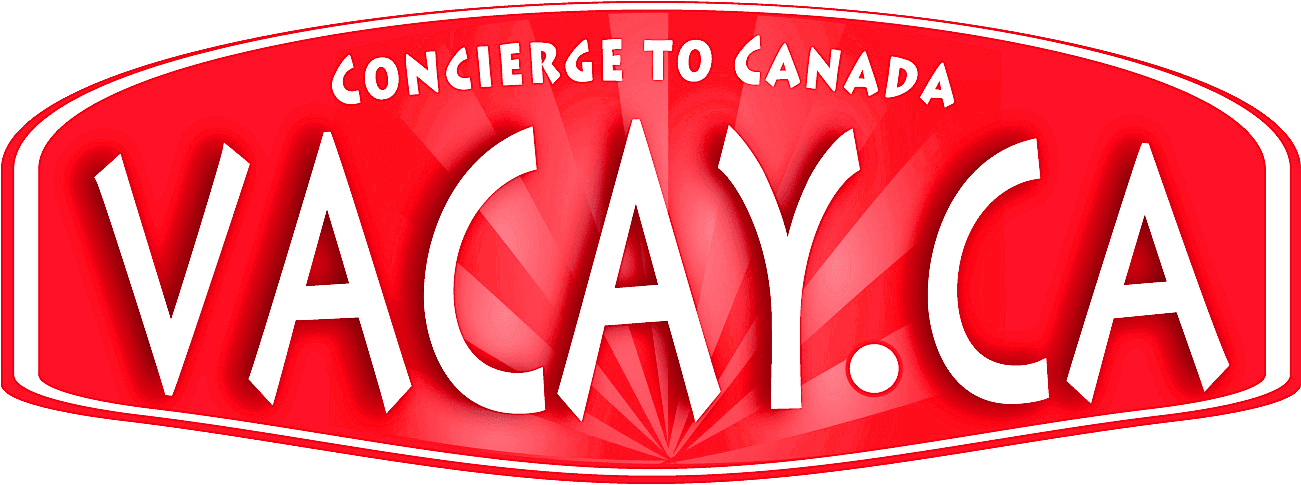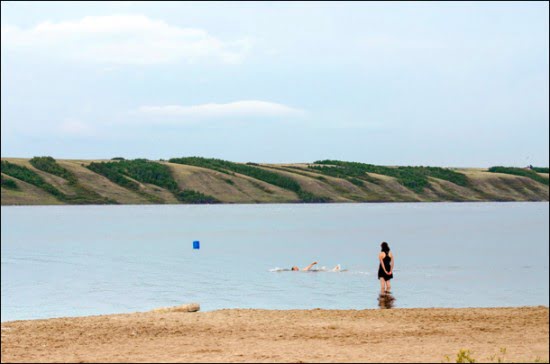
Little Manitou Lake in Saskatchewan is so rich in minerals that it is considered to have medicinal properties. (Julia Pelish/Vacay.ca)
[nggallery id=25]
Story by Adrian Brijbassi
Vacay.ca Managing Editor
MANITOU BEACH, SASKATCHEWAN — Debbie Farago remembers her mother taking a month to spend in this town that’s about halfway between Regina and Saskatoon and far away from anywhere you might imagine vacationing. She didn’t come for the water sports in the lake, because there aren’t any, or for the scenery, because there isn’t much to hold your eye. In fact, Manitou Beach, on first glance, seems more like a place people would want to escape. It takes a minute to traverse the length of the beach … if you walk slow. The one beachside bar, Mike’s, is dark and gloomy. A beach volleyball court alongside Little Manitou Lake keeps young people busy late into the night with a singular activity in this tiny town of 300.
When you drive up, you might wonder yourself what you are doing here and just how long you will spend. Not that it seems foreboding, dangerous or derelict. There just isn’t much here and what is in place doesn’t have visual appeal. Even the lake, the primary reason to visit, is murky and vacant.
Stick around, though, and after a day or two of exploring you discover that there’s much beneath the surface — in a literal and figurative sense. Farago is among those who say they’ve witnessed the difficult-to-explain phenomenon of a 22-kilometre-long lake that is unlike any other in North America. It was carved out by glaciers and the bottom of its bed has springs that shoot up minerals from within the earth. There’s magnesium, potassium, silica, iron oxide, calcium and sulphate amid this lake’s alchemy. Years ago, while suffering from eczema, Farago’s mother came to the area in the middle of Saskatchewan and dipped herself in the water for hours each day. After her visit, her irritating skin condition had healed.
“She knew the lake would help. She had eczema all over both of her shoulders and after a month it was gone,” says Farago while joining a conversation at the Village Perk, a cute, colourful coffee shop and bakery that’s the one business in Manitou Beach that wouldn’t look out of place in a big city.
Residents insist there’s magic in the waters of the lake, which spins out enough salt to play with the human body like a carnival ride. Similar to the Dead Sea, Little Manitou Lake is so dense swimmers can float without effort; drowning is near impossible. Proponents also insist this lake can heal and they have centuries of historical evidence to cite. Members of the prairie First Nations, including the Cree, believe the waters can cure diseases such as smallpox. They have dipped the sick into the lake and hailed the results.
More recent fantastic stories include rumour of a gangrene sufferer who sat in the water religiously for 12 hours a day for more than a week. According to more than one resident, the water healed his ailment and saved him from amputation.
Karen Worobec, who works at the Village Perk and also owns Burger Buoy, a fast-food stand that serves delicious homemade burgers, credits the water for healing an infection in her leg.
Healing Powers of Little Manitou Lake
In the 1930s, Little Manitou Lake was almost as popular with American and European tourists as Banff. It was nicknamed the Carlsbad of Canada, because its properties were similar to the Czech spa city of Carlsbad, or Karlovy Vary. A synagogue was built to serve the many Jewish visitors who travelled from overseas or eastern Canada. But railroad and highway infrastructure forced a change in vacation patterns, and Manitou Beach hasn’t recovered.
“People in Saskatoon, one hour away, haven’t heard of this place but we’ve had people from Europe come in here,” Worobec says while sitting by a window seat in the Village Perk, overlooking the lake. “They plan their holiday around coming here. Their doctors recommend mineral waters for health reasons.”
While the lake has had its abundance of claims of miraculous cures and a smattering of European visitors, it’s short on tourism. Earlier this year, Vacay.ca named Little Manitou Lake as one of the 12 Best Places to Travel in Canada for 2012. It was given that distinction because of the surreal experience its water offers and the fact the area’s primary tourist operation, the Manitou Springs Hotel and Mineral Spa, had successfully re-opened in 2011 after the provincial health department ordered it to close a year earlier. A ruling forced the spa to upgrade its water filtration and piping system. The hotel’s general manager, Eric Upshall, who doubles as the town’s mayor, insists the health department ruling was unnecessary because it did not take into account the unique quality of the lake waters.
A member of Saskatchewan’s provincial parliament for 13 years before becoming Manitou Beach’s mayor, Upshall said the addition of chlorine — due to another government mandate — led to a handful of bathers in the spa suffering mild skin rashes. The spa went through numerous tests during its closure to ensure guests would not incur any skin irritations and its pools, which first opened 25 years ago, would not lose the medicinal aspects that have brought them notoriety.
“We believe in this place so much, in the potency of the water,” says Upshall, who is refreshingly frank when it comes to the challenges of building a tourism industry in the middle of the Canadian prairies and attempting to do so by pitching the curative powers of mineral springs that haven’t been scientifically proven to heal. Mineral spas are hardly rare these days. Every region has several. Two hours away, Moose Jaw boasts a much more luxurious hotel that advertises a mineral spa but as Upshall points out the Manitou Beach springs feature waters that have a significantly higher concentration of minerals than any other spa in the country. With 180 grams/litre of minerals, Manitou Beach obliterates the standard of 1 gram/litre that many mineral spas contain. Its lake water is also five times more dense than the ocean because of the concentration of salt.
“You have to be careful about comparing mineral spas because at some level you’re asking the public, the consumer to believe your snake oil is better than someone else’s snake oil, but what we do know is there is no place else like this. That’s not knocking anyone else’s spa. The more spas the better. Anything that brings in tourists to Saskatchewan, we’re all for, but when people say they want a mineral spa experience where the water can actually help with ailments like arthritis and skin conditions and various joint pains, it’s really here they want to come,” Upshall says.
For someone who is a terrible swimmer, knowing you can venture into the water and not sink is an amazingly liberating feeling. I wanted to come to Little Manitou Lake because I visited the Dead Sea two years ago while on assignment in Israel and was enthralled with the thought I could replicate the ticklish feeling of floating with no exertion here in Canada. Earlier this year, I visited the Espiritu Santo Archipelago in Mexico’s Gulf of California, where the salinity is so high you can snorkel for hours once you trust that the waters will indeed keep you buoyant. However, the salinity level in the Gulf of California fluctuates because it is part of the Pacific Ocean, whereas the Dead Sea’s salt content is stable. Little Manitou Lake is about half as dense as the Dead Sea and nowhere near as popular, so the experience isn’t the same. That doesn’t mean the lake or the springs are a disappointment. The sensation on the skin is much the same, with a gentle stimulation that feels more effective than a heating pad on joint pain.
“The water is so dense with salts and minerals it has a specific gravity 10% higher than regular water. And that means it’s fun,” says Carol Perehudoff, one of Canada’s leading spa experts and Vacay.ca’s spa columnist, who also dropped in on Manitou Beach recently.
Judy Hoppe of Portland, Oregon was visiting Saskatchewan for the first time in August when she took a swim in the lake. “It does something to your skin. You can really feel it,” she said while taking a break from doing the polka at Danceland, a 5,000-square-foot hall that is the other main attraction in town. “We have springs down in Oregon and a spa too but they pipe in the water. There’s nothing natural like it is here.”
Visiting Manitou Springs
Upshall is serious about making Manitou Beach and nearby Watrous a tourist draw and there’s an opportunity to build an experience around the town’s retro look and feel. Along with the lake, the area features Danceland (which dates to 1928 and has one of North America’s few remaining floors padded with horse hair), the continent’s oldest bird sanctuary, one of only four remaining drive-ins in Saskatchewan, and an Anglican church with a 500-year-old stained-glass window that was shipped in 2,000 pieces from England. While Upshall would love it if his community turned into an attraction for all of Canada and the world, the focus at the moment is on drawing visitors from within driving distance. That’s a good plan, because the people who should come to Manitou Beach are the residents from elsewhere in Saskatchewan. Manitou Beach is an underdog community in a province that embraces its underdog stature. The beloved Saskatchewan Roughriders of the Canadian Football League have as devoted a fan base as any team anywhere in any sport, despite having won only three Grey Cup titles in their 100-year history.
Until its recent rise to prominence as an economic powerhouse, Saskatchewan was a province that people fled to find opportunities elsewhere and except for its sport-fishing offerings it lacks a reputation for tourism. In a way, Manitou Beach suffers from the “Why would you go there?” stigma from within its own province. I found that people in other cities of Saskatchewan don’t have a high opinion of the town. They either hadn’t been in years or had heard about the shut down of the mineral springs and were leery of visiting. That’s too bad. As Upshall says, “We’re open for business and we’re ready to announce it as loud as we can.”
Those nearest to his community should be the first to hear the call.
Whether the healing properties of Little Manitou Lake exist or its powers are simply a matter of state of mind is eternally debatable. Unlike the Dead Sea, where proponents speak of its medicinal powers with the fervour of a preacher, the advocates in Manitou Beach tend to take a pragmatic outlook on their water, an attitude that also helps to put visitors at ease. As Farago points out with a smile, her mother’s eczema may have healed up because of the lake but “being away from Dad didn’t hurt either.”
That relaxed attitude helps a visitor make up his mind for himself about the lake and the springs. With the cold air arriving to twinge old sports injuries into complaint, the thought of sinking into the spa and again feeling the sensation of its soothing waters is something my mind lingers on more and more. It’s why I know I will be back to this little town that really does have a lake full of mystery and magic.
More About Manitou Beach and the Manitou Beach Hot Springs
Location: Manitou Springs Hotel & Mineral Spa is at 302 McLachlan Ave., Manitou Beach, SK (see map below)
Nightly hotel rates: Rooms range from $119.95 to $169.95, pool admittance included
Mineral spa prices: Pool admission starts at $10.95 for an adult swim or $14.95 for a day pass.
Telephone: 1-800-667-7672
More info on Saskatchewan: Read Vacay.ca’s coverage of Saskatoon and be sure to check back for an upcoming video on Danceland.
View Larger Map









6 Comments
Sandi
February 7, 2014 at 5:04 pmI learned about Manitou Lake after watching a movie called Hard Core Logo 2. I wondered how I had lived my entire life on the Prairies and not been aware of Canada’s own inland sea. I visited in the winter so stayed in the hotel with the pool. Although I have yet to experience the spa services (massage etc.) I spent a lot of time in the pool. WONDERFUL!!! What can I say? it was elevating. I have been back four times, always in the winter – always when I feel my spirits need to be lifted and my heart is too heavy to do it alone. It never disappoints.
Vicky Vacay
February 9, 2014 at 5:25 pmGreat comment, Sandi. So glad you discovered this remarkable place in Canada. Manitou Beach has something magical about it for sure.
Skihist
October 29, 2017 at 12:20 amIt’s Little Manitou Lake. Manitou Lake is a fresh water lake.
DP
May 29, 2014 at 6:50 pmWhat is the difference between Manitou Lake and Little Manitou Lake? Which one is better to visit? Can you please answer my question. I would appreciate.
Vicky Vacay
May 30, 2014 at 10:05 pmHi,
Manitou Lake is on the western edge of Saskatchewan, 360 km away from Little Manitou Lake. Little Manitou Lake has the town of Manitou Beach and the famous spa facility that pipes in the salt water and also has other attractions like Danceland. Manitou Lake, though larger, doesn’t have such facilities. Both lakes are salt water and have the high mineral content similar to the Dead Sea, however, Little Manitou Lake has the tourism infrastructure in place that makes it a worthwhile destination for travellers. We hope that helps. Please share your photos and stories when you visit — you’ll win a travel prize!
Vicky
Skihist
October 29, 2017 at 12:19 amLittle Manitou Lake is a mineral lake high in salts. 4.5 times as buoyant as the ocean and half of the Dead Sea. Manitou lake is your average fresh water lake. Little Manitou is the more famous with a nice hotel spa for when the water is too cold.